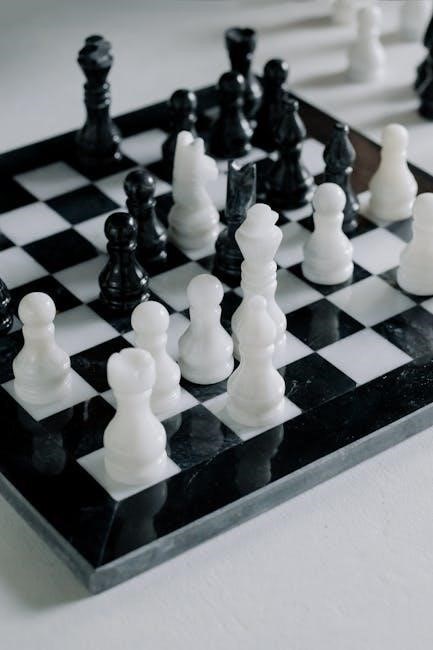Chess strategy and tactics involve mastering principles like checkmate, king safety, and material gain. Resources like Yusupov’s “Build Up Your Chess” and Bricard’s exercises offer structured learning. Digital books provide convenience, while physical ones suit personal preference, aiding players in refining their gameplay effectively.

Basic Principles of Chess Strategy
Understanding chess strategy involves mastering fundamentals like controlling the center, piece development, and pawn structure. Key principles include securing king safety, creating threats, and optimizing material efficiency effectively.
2.1. Key Concepts in Chess Strategy
Mastering chess strategy begins with understanding fundamental concepts like control of the center, piece development, and pawn structure. These elements form the backbone of effective play, enabling players to dictate the game’s flow. Key principles include maintaining king safety, creating threats, and exploiting weaknesses. Tactical motifs such as forks, pins, and skewers are essential for gaining material or positional advantages. Players must also recognize patterns like discovered attacks and double checks, which can decisively turn the tide. By integrating these concepts into their gameplay, chess enthusiasts can build a solid foundation for long-term improvement and success.
2.2. Common Mistakes to Avoid in Strategic Play
Avoiding common mistakes is crucial for improving chess strategy. Overtrading pieces without considering long-term consequences is a frequent error, as is neglecting king safety. Many players move the same piece multiple times in the opening, wasting valuable time. Others chase unnecessary threats, losing focus on their own plan. Ignoring pawn structure can lead to irreversible weaknesses. Players often fall into tactical traps by not seeing “discovered” threats. Overextending pawns without piece support is another pitfall. Lastly, failing to transition smoothly from the middlegame to the endgame can squander hard-earned advantages. Recognizing these mistakes helps players refine their strategy and avoid repeating them.

The Opening Phase of Chess
The opening phase sets the foundation for the game, focusing on quick development, controlling the center, and safeguarding the king. Avoid unnecessary pawn moves and premature attacks to maintain flexibility and harmony among pieces.
3.1. Popular Opening Systems and Variations
Popular opening systems like the Ruy Lopez, Sicilian Defense, and Italian Game are widely used due to their strategic depth. The Ruy Lopez excels at quick development and control of the center, while the Sicilian Defense offers asymmetrical play. Variations such as the Open Sicilian and Closed Ruy Lopez provide flexibility. Players often choose openings that align with their style, whether aggressive or positional. Resources like Yusupov’s “Build Up Your Chess” and Bricard’s exercises help master these systems. Digital tools and videos, such as those from Chess Vibes, also guide learners through complex variations, making it easier to adopt these openings effectively in games.
3.2. Effective Move Orders in the Opening
Effective move orders in the opening are crucial for controlling the center and developing pieces harmoniously. Systems like the Italian Game and Ruy Lopez emphasize quick development and pawn structure stability. Players must understand how move sequences influence strategic goals, such as gaining space or preparing for tactical blows. Resources like Yusupov’s “Build Up Your Chess” and Bricard’s exercises highlight the importance of precise move orders. Digital tools and videos from channels like Chess Vibes also provide insights into optimizing opening play. By mastering these sequences, players can transition smoothly into the middlegame with a strong position, aligning their moves with their overall strategic objectives.

The Middlegame Strategies
Middlegame strategies involve analyzing positions, identifying tactical motifs, and transitioning smoothly from opening principles. Players must adapt to pawn structures and exploit weaknesses while preparing for the endgame.
4.1. Identifying Tactical Opportunities
Identifying tactical opportunities in the middlegame requires a sharp eye for patterns and a deep understanding of chess fundamentals. Players must constantly analyze the board to uncover threats, such as forks, pins, and skewers. Forks, where a single move attacks multiple pieces, can be devastating. Pins, which trap an opponent’s piece against a more valuable one, often lead to material gains. Skewers, the reverse of pins, can also force concessions. Additionally, double attacks and discovered checks can disrupt the opponent’s position. Regular practice with tactical puzzles, as recommended in resources like Yusupov’s “Build Up Your Chess,” sharpens these skills. Calculating variations and anticipating opponent responses is crucial for seizing tactical chances effectively.
4.2. Making Strategic Decisions in the Middlegame
Making strategic decisions in the middlegame involves balancing short-term tactical gains with long-term positional goals. Players must evaluate factors like pawn structure, piece activity, and king safety to guide their moves. Controlling key squares and open lines can create lasting advantages. Transitioning smoothly from tactics to strategy requires foresight, as missed opportunities can shift the game’s momentum. Resources like Yusupov’s “Build Up Your Chess” emphasize the importance of understanding positional concepts. Additionally, studying grandmaster games and using tools like Chessable can refine decision-making skills. Constantly asking questions about the opponent’s plans and calculating variations are essential for making informed, strategic choices during this critical phase of the game.
The Endgame Techniques
Mastering endgame techniques ensures victory in the final stages. Transitioning smoothly from the middlegame and utilizing resources like Yusupov’s books refine endgame strategies effectively.
5.1. Essential Endgame Techniques
The endgame is a critical phase where strategy often determines the outcome. Key techniques include king activation, pawn promotion, and exploiting material advantages. Players must master basic checkmates, such as king and rook versus king, and king and bishop versus king. Timing is crucial, as transitioning smoothly from the middlegame ensures retained advantages. Tactical motifs like forks and skewers remain potent in the endgame, forcing opponents into defensive crises. Additionally, understanding zugzwang and triangulation can secure victories. Properly utilizing passed pawns and creating threats on both wings can overwhelm defenses. Mastery of these techniques transforms endgames into decisive stages, turning slim leads into wins. Regular practice with puzzles and study of grandmaster endgames refine these skills, ensuring consistent success.
5.2. Transitioning from Middlegame to Endgame
Transitioning from the middlegame to the endgame requires precise timing and strategic awareness. The goal is to simplify the position while maintaining a material or positional advantage. Key objectives include activating the king, creating passed pawns, and securing control of key squares. Tactical opportunities in the middlegame often set the stage for a favorable endgame. Players must avoid unnecessary complications and focus on converting advantages into a winning endgame. Simplifying the position by exchanging pieces and pawns strategically can make the endgame more manageable. Properly executed transitions ensure that middlegame gains are not squandered, allowing players to leverage their advantages effectively in the final phase of the game.
Tactical Motifs in Chess
Tactical motifs like forks, pins, skewers, and double attacks are essential in chess. They create threats, forcing opponents into unfavorable positions, often leading to material gain or checkmate.
6.1. Understanding Forks and Double Attacks
A fork is a tactical motif where a single piece attacks two or more of the opponent’s pieces simultaneously. This forces the opponent to choose which piece to save, often leading to material gain. Double attacks involve two pieces targeting the same enemy unit, overwhelming its defense. Both tactics rely on precise calculation and positioning. For example, a knight fork can attack both the king and queen, while bishops or rooks can deliver double attacks along diagonals or ranks. To execute these effectively, players must spot vulnerable positions and coordinate their pieces. Regular practice with puzzles and studying master games can enhance recognition and execution of these motifs.
6.2. Utilizing Pins and Discovered Attacks
Pins and discovered attacks are powerful tactical weapons in chess. A pin occurs when a player attacks an opponent’s piece that is protected by a more valuable piece, forcing the opponent to move the defended piece or face loss. Discovered attacks involve moving a piece to reveal a threat from another piece behind it. These tactics often lead to material gain or positional advantages. For example, a bishop pinning a knight against a queen can force the knight’s retreat or capture. Similarly, a discovered check can create immediate threats. Mastering these motifs requires recognizing patterns and calculating outcomes. Regular practice with tactical puzzles and studying master games can enhance proficiency in executing pins and discovered attacks effectively.
6.3. Applying Skewers and Other Tactical Motifs
Skewers are a tactical motif where a player attacks an opponent’s piece, forcing it to move and expose a more valuable piece behind it. For example, attacking a queen in front of a king or a rook behind a knight. This tactic often leads to material gain or a significant positional advantage. Other motifs include forks, pins, and discovered attacks, which can be combined with skewers to create devastating threats. Recognizing these patterns is crucial for improving tactical play. Regular practice with puzzles and study of master games help refine the ability to apply skewers and other motifs effectively. Mastery of these techniques enhances a player’s ability to outmaneuver opponents and achieve victory.
6.4. Mastering Discovered and Double Checks
Discovered checks and double checks are advanced tactical motifs that can decisively turn the tide of a game. A discovered check occurs when a piece moves, uncovering a check from another piece, often forcing the opponent into a vulnerable position. Double checks involve delivering two checks simultaneously, typically with a king and queen or rook, which can lead to checkmate. These motifs require precise calculation and foresight, often involving sacrifices to set up the position. Players should study master games and practice tactical puzzles to recognize and execute these patterns effectively. Mastery of discovered and double checks enhances a player’s ability to deliver decisive blows and achieve victory.
Analyzing Games of Grandmasters
Analyzing grandmaster games reveals strategic concepts, tactical motifs, and endgame techniques. Studying their moves helps improve decision-making and understanding of positional play, enhancing overall chess skills effectively.
7.1. How to Analyze Grandmaster Games Effectively
To analyze grandmaster games effectively, focus on understanding the strategic and tactical ideas behind each move. Start by reviewing the game without annotations, noting key moments and decisions. Then, compare your thoughts with grandmaster commentary to identify patterns and concepts. Pay attention to pawn structures, piece placement, and long-term plans. Study how grandmasters transition between phases of the game and handle tactical motifs. Slow down the analysis to grasp the reasoning behind critical moves. Use tools like Chessable or video lectures to deepen your understanding. Regularly analyzing master games helps bridge the gap between theory and practice, enhancing your own strategic and tactical skills over time.
7.2. Benefits of Studying Master Games
Studying master games offers invaluable insights into chess strategy and tactics. By examining how grandmasters handle various positions, players can improve their understanding of key concepts like pawn structures, piece activity, and tactical motifs. Observing how masters transition between game phases and execute long-term plans enhances decision-making skills. Additionally, analyzing master games helps identify common patterns and ideas, which can be applied in personal play. Digital resources, such as Chessable and video lectures, make these games accessible and portable. Regular study of master games accelerates learning, bridges the gap between theory and practice, and inspires players to adopt strategic and tactical approaches in their own games, fostering overall improvement.

Recommended Resources for Learning
Top PDFs like Yusupov’s “Build Up Your Chess” and Bricard’s exercises provide structured learning. Digital books offer convenience, while physical copies suit personal preference, aiding effective study.
8.1. Top PDFs and Books on Chess Strategy
Improving chess strategy requires high-quality resources. Popular books like “Build Up Your Chess” by Artur Yusupov and “Strategic Chess Exercises” by Bricard offer structured lessons. Digital PDFs provide convenience, with titles like “My 60 Memorable Games” by Bobby Fischer and “How to Reassess Your Chess” by Jeremy Silman being highly recommended. These resources cover essential tactics, strategic planning, and practical exercises. Digital books are affordable and portable, while physical copies offer a traditional learning experience. Combining these materials with regular practice ensures steady improvement in chess strategy and overall gameplay effectiveness for players of all skill levels.
8.2. Digital vs. Physical Books: Pros and Cons
Digital books offer affordability and portability, making them ideal for on-the-go learning. They are easily accessible and require minimal storage space. However, some players prefer physical books for their tactile experience and ability to annotate. Physical books often provide a more immersive learning environment without digital distractions. On the downside, they can be bulky and expensive. Digital books, while convenient, may cause eye strain and lack the traditional feel of paper. The choice between digital and physical ultimately depends on personal preference and learning style. Both formats have their advantages, ensuring players can access high-quality chess strategy resources in a way that suits them best.
Practical Exercises and Puzzles
Practical exercises and puzzles are essential for improving chess skills. Tactics books like Yusupov’s and Bricard’s, along with online platforms like Chessable, offer structured learning. Regular practice enhances pattern recognition and critical thinking, helping players apply strategies effectively in real games.
9.1. Solving Tactics Puzzles Regularly
Solving tactics puzzles regularly is essential for improving chess skills. These exercises enhance calculation abilities, pattern recognition, and decision-making. Players learn to identify forks, pins, and other tactical motifs, applying them in real games. Starting with basic puzzles and gradually increasing difficulty helps build confidence. Resources like Yusupov’s “Build Up Your Chess” and Bricard’s exercises provide structured practice. Digital platforms and books offer convenient access to a wide range of problems. Consistent practice sharpens instincts, allowing players to anticipate opportunities and threats. Reviewing missed puzzles reinforces learning, ensuring steady progress. Regular tactical training is a cornerstone of chess improvement, transforming players into formidable opponents.
9.2. Using Chess Software for Training
Chess software is an invaluable tool for modern players, offering interactive exercises, analysis, and personalized learning paths. Platforms like Chessable and Lichess provide extensive libraries of tactics puzzles, allowing players to practice specific themes. Software also enables game analysis, highlighting mistakes and suggesting improvements. Video resources, such as those from GothamChess and Chess Vibes, complement books by delivering lessons in an engaging format. Many programs adapt to skill levels, ensuring challenges remain appropriate. Regular use of chess software accelerates progress, as it combines theoretical knowledge with practical application. Tracking progress and focusing on weaknesses helps players refine their skills systematically. This blend of convenience and effectiveness makes software a key component of modern chess training.
Effective Training Methods
Effective chess training involves regular tactics puzzles, group study sessions, and structured learning plans. Resources like Yusupov’s books and online channels provide comprehensive guidance for improvement.
10.1. Creating a Structured Study Plan
A well-organized study plan is essential for improving chess skills. Start by setting clear, achievable goals, such as mastering specific strategies or increasing tactical accuracy. Allocate time for daily practice, balancing tactics puzzles, theoretical study, and game analysis. Incorporate resources like Yusupov’s “Build Up Your Chess” and Bricard’s exercises for structured learning. Dedicate sessions to reviewing grandmaster games and experimenting with new ideas in your own play. Regularly assess progress and adjust the plan to address weaknesses. Consistency is key; even short daily sessions can yield significant improvement over time. Combine digital tools, like Chessable, with traditional books to diversify your learning approach.
10.2. Engaging in Group Study Sessions
Group study sessions offer a dynamic way to enhance chess learning. Collaborating with fellow players fosters a competitive yet supportive environment, encouraging the exchange of ideas and strategies. Analyzing games collectively helps identify missed opportunities and strengthens problem-solving skills. Players can discuss tactical motifs, review grandmaster games, and solve puzzles together, leveraging each other’s strengths. Sharing insights and resources, such as Yusupov’s “Build Up Your Chess” or Bricard’s exercises, enriches the learning experience. Group sessions also promote accountability and motivation, as players challenge and inspire one another. Regular meetings ensure consistent progress, making group study a valuable complement to individual practice for improving chess strategy and tactics effectively.
Mastering chess strategy and tactics requires dedication, consistent practice, and a well-structured approach. By leveraging resources like Yusupov’s “Build Up Your Chess” and Bricard’s exercises, players can deepen their understanding of key concepts. Regular tactical puzzles, analysis of grandmaster games, and group study sessions enhance learning. While digital tools offer convenience, physical books provide a tactile experience, catering to individual preferences. Ultimately, a combination of theoretical knowledge and practical application is essential for improvement. Whether through individual effort or collaborative learning, continuous study and reflection will guide players toward chess excellence, helping them navigate complex positions with confidence and precision.